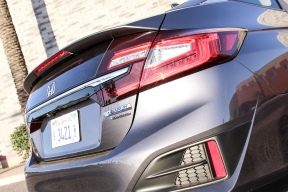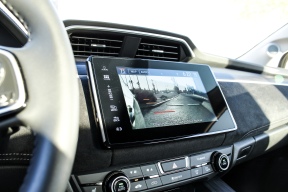How Far Can You Go?: 2018 Honda Clarity Plug-In Hybrid Tested

It has been nearly a decade since the fuel crisis that struck American soil and left us paying over $5.00 or more per gallon. When the going got tough, we resorted to alternative fueled and powered vehicles. Since then, while the price of fuel will always fluctuate, it mostly has leveled out, but that doesn’t mean car companies haven’t stopped trying to find new ways to increase alternative ways of getting from Point A to Point B using the least amount fossil grade resources. Thus, its Honda turn to re-introduce their take with the new Clarity Plug-In Hybrid.

Like other plug-in hybrids, the Honda Clarity holds a level of complexity that only an engineer could love. With power being driven from a 181-horsepower electric motor and a 17.0-kWh lithium-ion battery pack, backed up by a 1.5-liter, 103-horsepower four-cylinder engine, performance can total out to 212-combined horsepower when working together. Though, unless you’re late for this week’s school runs carpool, it’s an unlikely circumstance that all that power will be used at the same time.

To shed some light on the Clarity and its complicated algorithm – for starters it uses three drive modes to control the amount of aggression behind one’s driving style between Econ, Normal and Sport. Then, there is the controllable regenerative-braking system that can be managed through the steering wheels paddle shifters, with four selectable modes, its controls the amount of force that can be applied to help charge the battery while also slowing down at a quicker rate. And then there are three additional options to optimize how the battery can be charged. Oy vey.

Despite all this, the Clarity is in fact a simple car to operate. At each start it resets to its default settings working mainly of its electric charge. On a 110-volt outlet it can take 12 or more hours to obtain a full charge while a 240-volt outlet or charging station can do it in about two and half hours and provide up to an EPA rated 48 miles of electric range. In a sense, the 1.5-liter engine works like a generator when the batteries are low, it can charge up the batteries while at a steady cruise while also powering the front wheels to continually propel the Clarity forward. The gasoline engine can get up to 350 miles of range which ultimately gives the Clarity almost 400 miles of drivable distance.

In a sense, the Clarity drives similar to its Accord sibling, if the Accord was bloated – the Clarity weighs nearly 1,000 pounds more. But because the batteries are located behind the backseat, it provides a nice center of gravity. Ultimately, the Clarity is plush and well in tuned to providing a leisurely drive. The steering, while not very assertive, carries a well-tuned weightiness to its motion that provides an attractive driving feel. The suspension is also noble in its responsiveness and avoids any unwanted harsh impacts or rude road behavior.

Just because it has an electric motor, the Clarity is no Tesla. It’s quick enough for the day to day routine and thrusts to highway speeds like any ordinary four-cylinder sedan. At depleted power, there is a noticeable change in performance as there isn’t much torque from the gasoline engine to chug it along like the electric motor, but it does the job resourcefully. Considering our real world daily lives consisted of less than 50 mile drive routes, we managed to use the majority of the electric motor during our test. However, after a long day of shooting pictures and a night out on the town, we switched modes to have the Clarity used its gasoline engine to recharge while at highway cruising speeds. This is were we manage to see over 100 MPGe fuel consumption. Given reality though, EPA estimate the Clarity to achieve 47 MPGe using limited charging points.

With all the efforts to keep pushing electric and cross-electric hybrid vehicles the thought behind their designs is a bit unconventional. Taking in account aerodynamics, the Clarity uses a healthy contrast of design elements like the LED headlights and curvature of the LED daytime running lights. The 17-inch wheels fits the Clarity’s overall stature. But as we linger towards the rear, it starts a look a bit more in that unconventional territory with the rear wheel being covered – it’s like seeing my grandmother in a mini-skirt two sizes too big – it just doesn’t look right.
Because the Clarity is mostly electric, it’s quiet. The cabin is well insulated and isolating from the outside world, and thus providing a comfortable space to spend time in. It provides that Honda premium feel on the interior that we’re starting to notice in most of their cars. Keeping to a simplistic state of mind, the Clarity offers very attractive matte wood and suede finishes throughout the door panels and dash which is then outlined by a very stylish chrome trimming.

The Clarity starts at $33,400. Opting for the Touring, as seen here, comes with a $3200 up-charge and upgrades to leather upholstery, power adjustable seats, Navigation and remote Climate Pre-Conditioning (fancy terms for remote start.) All models come standard with an Apple CarPlay & Android Auto compatible 8-inch touch screen display, Honda Safety Sensing (Adaptive Cruise Control, Pre-Collision Detection & Autonomous Braking, Lane Departure Warning & Lane Keep Assist) and Honda Lane Watch.
The Clarity is taking electric plug-in hybrids to the next level with the amount of engineering and technology featured underneath. With the ability to travel upwards to 50 miles on electric range is more than most commutes and allowing more free range driving on an electric charge. How far can you go without using an ounce of gas? We can imagine pretty far.

| Vehicle Specifications: | |
| 2018 Honda Clarity Plug-In Hybrid Touring: | $36,600 |
| As Tested (including Options & Destination): | $37,490 |
| Performance Specs: | |
| 1.5-liter Four-Cylinder & Electric Motor – 212-Combined Horsepower, CVT Automatic Transmission – 0-60MPH: Not Tested | |
| EPA MPG: 44/40/42/110e (City/Highway/Combined/Electric&Gas Combined) – SSB Average: 77.3 MPGe’s – Fuel Range: ±356 Miles / 54 EV Miles | |









1,000 pounds heavier than an Accord! Yowza. Agreed on the controversial “wheel skirts” being a little wild, but otherwise this is an OK looking econo-ride. I want to see some zero-to-sixty figures on this little hot rod. Too bad I didn’t take this one for a spin.
Other sources report about 7.5 seconds to sixty. Which is pretty good considering the Prius can take about 9 seconds. ‘Tis a shame you missed out, I wonder what your followers would think about it.